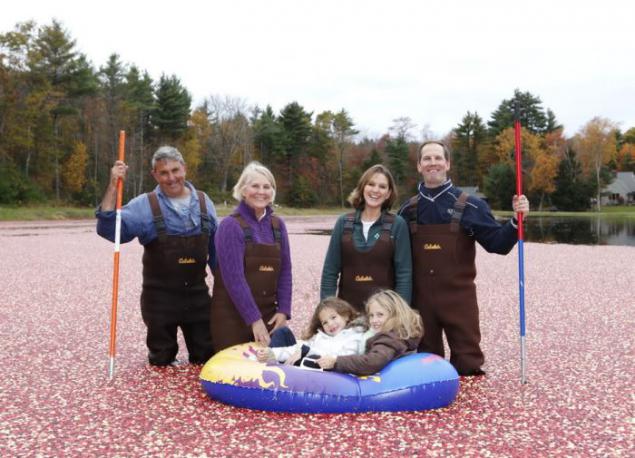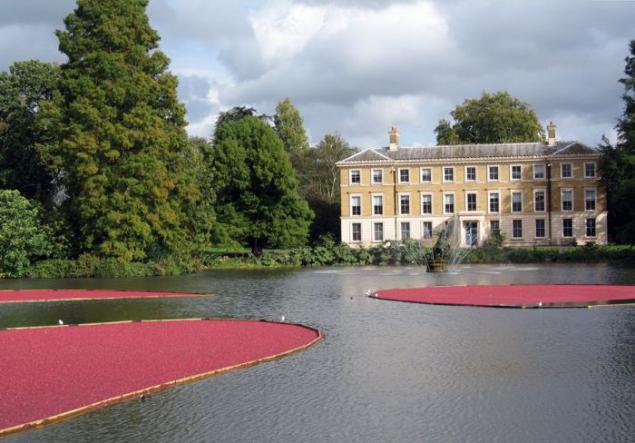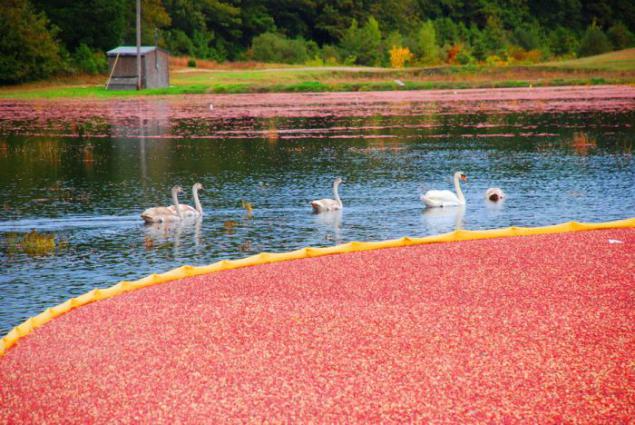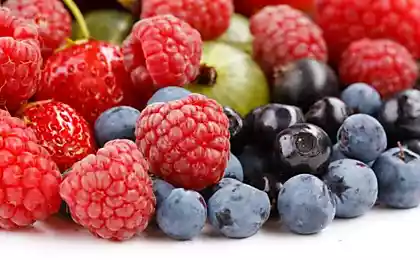983
Branchy cranberry. Everything about it (18 photos)
Cranberry (lat. Oxycoccus) - heath family plant that grows in bogs in the Northern Hemisphere.
Rich in vitamins and trace elements cranberries are used to prepare fruit drinks, juices, kvass, extracts and jellies.
The berries are used as antiscorbutic, for colds, rheumatism,
angina, beriberi, as well as in the food and alcoholic beverage industry.

Vaccinium macrocarpon the XIX century is grown on special plantations (checks). The largest producer of this fruit is the United States, there are also plantations in Canada, Belarus, Poland and the Scandinavian countries.

Feature large-fruited cranberries grown in large quantities in the United States and Canada, it is that its fruits are airbags, so this is one of the few berries floating on the water surface. This makes the collection of berries significantly less time consuming than conventional manual collection.

At the end of the season with ripe berry checks filled with water and allowed special processors that churn the water, with ripe berries come off. Then rounded up all the berries to one edge of the check where it - clean and washed - draw it out for further processing.



The Latin word derived from the Greek oxycoccos. ὀξύς («sour») and Greek. κόκκος («berry"), to taste the fruit. The first European settlers called cranberries "Sraneberry" (literally. Berry-pie), as disclosed in the stems of the flowers reminded them of the neck and head of crane. In Russia it was also called stoneflies, zhuravihoy, podsnezhnitsey, swamp grapes. In the 17th century New England cranberries sometimes called «Bearberries» (letters. "Bear fruit"), as people are often seen as the bears ate it.

One of the features of cranberries is that its berries can be kept fresh until the next harvest in wooden barrels filled with water.

American Indians rubbed cranberries into a paste and mixed with dried meat to extend its shelf life; This mixture is called "pemmican».

It is believed that cranberry juice is prepared for the first time American settlers in 1683. And in 1912 the first canned cranberry sauce.

Cranberry - a perennial plant. Some cranberry bushes live to be a hundred.

Cranberries and juice and juice from it protect teeth from decay. Fresh cranberry juice can neutralize the bacteria Escherichia coli.

The fruits cranberries are rich in vitamin C, this equating to oranges, lemons, grapefruit, strawberry. Among other fruits contain vitamins B1, B2, B5, B6, PP. Cranberry is a valuable source of vitamin K1 (phylloquinone), not yielding to the cabbage and strawberries.

In nature, all kinds of cranberries grow in damp places: in the transition and bogs, sphagnum pine forests, sometimes - on the swampy shores of the lakes. Cranberry is very light-requiring, but not demanding to mineral nutrition.





a source
Rich in vitamins and trace elements cranberries are used to prepare fruit drinks, juices, kvass, extracts and jellies.
The berries are used as antiscorbutic, for colds, rheumatism,
angina, beriberi, as well as in the food and alcoholic beverage industry.

Vaccinium macrocarpon the XIX century is grown on special plantations (checks). The largest producer of this fruit is the United States, there are also plantations in Canada, Belarus, Poland and the Scandinavian countries.

Feature large-fruited cranberries grown in large quantities in the United States and Canada, it is that its fruits are airbags, so this is one of the few berries floating on the water surface. This makes the collection of berries significantly less time consuming than conventional manual collection.

At the end of the season with ripe berry checks filled with water and allowed special processors that churn the water, with ripe berries come off. Then rounded up all the berries to one edge of the check where it - clean and washed - draw it out for further processing.



The Latin word derived from the Greek oxycoccos. ὀξύς («sour») and Greek. κόκκος («berry"), to taste the fruit. The first European settlers called cranberries "Sraneberry" (literally. Berry-pie), as disclosed in the stems of the flowers reminded them of the neck and head of crane. In Russia it was also called stoneflies, zhuravihoy, podsnezhnitsey, swamp grapes. In the 17th century New England cranberries sometimes called «Bearberries» (letters. "Bear fruit"), as people are often seen as the bears ate it.

One of the features of cranberries is that its berries can be kept fresh until the next harvest in wooden barrels filled with water.

American Indians rubbed cranberries into a paste and mixed with dried meat to extend its shelf life; This mixture is called "pemmican».

It is believed that cranberry juice is prepared for the first time American settlers in 1683. And in 1912 the first canned cranberry sauce.

Cranberry - a perennial plant. Some cranberry bushes live to be a hundred.

Cranberries and juice and juice from it protect teeth from decay. Fresh cranberry juice can neutralize the bacteria Escherichia coli.

The fruits cranberries are rich in vitamin C, this equating to oranges, lemons, grapefruit, strawberry. Among other fruits contain vitamins B1, B2, B5, B6, PP. Cranberry is a valuable source of vitamin K1 (phylloquinone), not yielding to the cabbage and strawberries.

In nature, all kinds of cranberries grow in damp places: in the transition and bogs, sphagnum pine forests, sometimes - on the swampy shores of the lakes. Cranberry is very light-requiring, but not demanding to mineral nutrition.





a source























